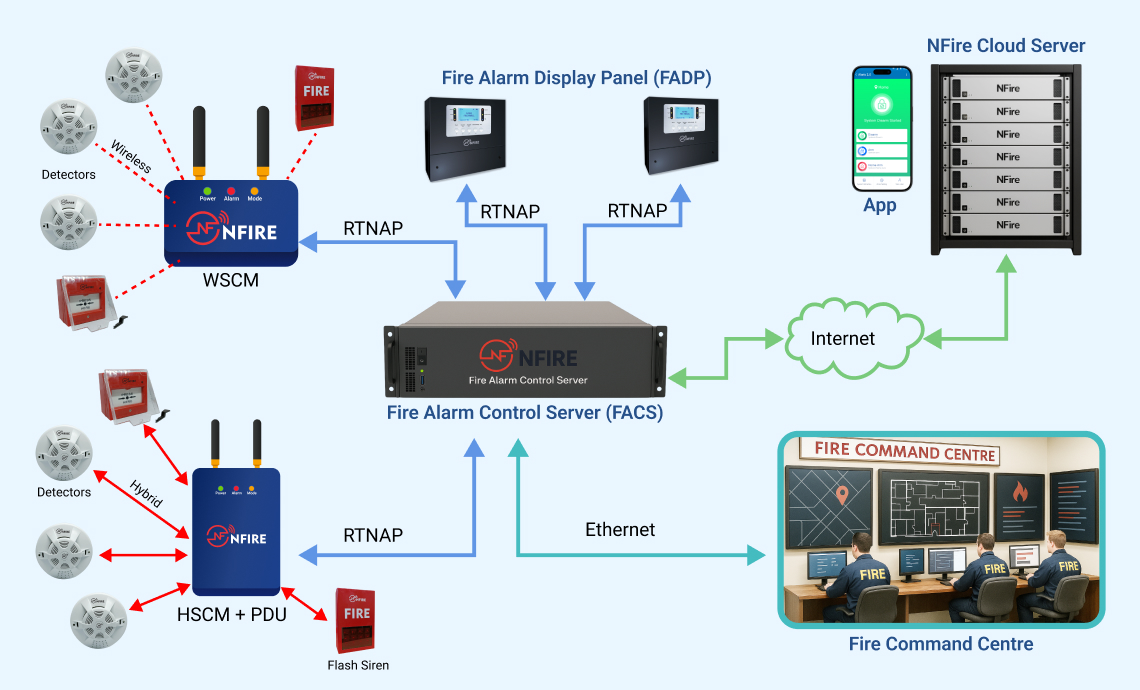Commercial buildings today face increasingly complex fire‐safety challenges. Recent industry data indicates that up to 80% of fire alarms in commercial buildings are false alerts, costing organisations an estimated ₹2.5 crore annually in lost productivity and emergency response fees. Traditional fire alarm systems—relying primarily on basic smoke or heat detectors—often generate false alarms due to benign causes like cooking fumes, dust accumulation, or routine maintenance. These nuisance alerts disrupt business operations, erode occupant confidence, and can desensitize both staff and emergency responders to genuine threats. Moreover, conventional systems provide limited visibility into how a fire develops, hampering facility managers’ ability to anticipate risks and coordinate an effective response.
Enter the era of Artificial Intelligence (AI) combined with the Internet of Things (IoT)—collectively known as AIoT. By weaving intelligent analytics into a distributed network of smart sensors and devices, AIoT fire alarm systems can detect the faintest signs of a developing fire, suppress false alarms, and automate emergency protocols. In India’s dynamic commercial landscape, NFire’s AI fire alarm system India solution delivers real‐time insights, predictive alerts, and seamless integration with existing building management systems (BMS), setting a new benchmark for reliability and safety.

AIoT fire alarm benefits include up to a 50–70% reduction in detection time compared to conventional systems. Early alerts minimize property damage, curtail downtime, and save lives—each minute shaved off response time can drastically improve rescue outcomes and limit fire spread.
Modern commercial properties run a mosaic of systems—lighting, HVAC, access control, energy management, and more. IoT fire safety solutions like NFire’s AIoT platform integrate natively with existing BMS, allowing:
Indian regulations—such as the National Building Code (NBC) and the Factories Act—mandate rigorous fire-safety protocols. AIoT platforms generate detailed audit trails, logging every sensor reading, alarm event, and response action. This comprehensive documentation streamlines compliance reporting and bolsters facility managers’ ability to demonstrate adherence to statutory requirements.
Context: A typical commercial building aims to reduce nuisance alarms in busy areas like the break room and speed up fire response in critical zones such as the server room.
This solution shows how NFire’s AIoT system integrates with everyday building operations, quickly identifying real fire threats while avoiding disruptions from false alarms and maintaining organized records for compliance.
NFire’s AIoT fire alarm system India platform exemplifies the future of intelligent fire safety:
The fusion of AI and IoT is ushering in a new era of fire safety for commercial buildings. By leveraging real‐time analytics, predictive modeling, and automated emergency coordination, AIoT fire alarm solutions like NFire are redefining reliability, responsiveness, and regulatory compliance. For facility managers and safety officers, upgrading to an AIoT fire alarm system is not merely a technological enhancement—it’s an essential strategy to safeguard assets, reputation, and lives.
Ready to elevate your fire safety?
Explore how NFire’s AIoT fire alarm system can transform your commercial property’s safety infrastructure. Contact us today for a personalized consultation on how NFire can bring the future of intelligent fire safety to your building.
To know more about NFire IoT based Wireless Fire Alarm System